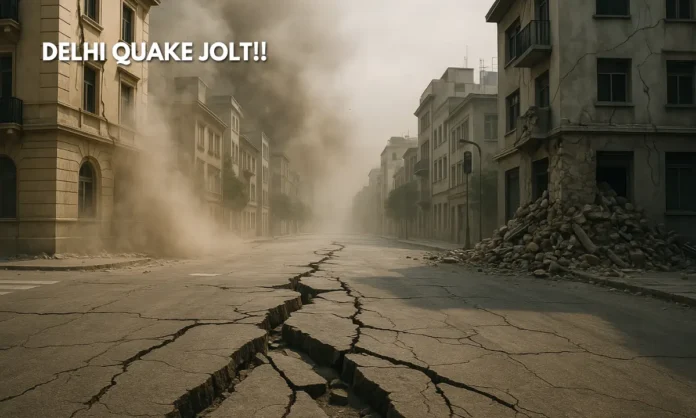SUMMARY
- A 4.4 magnitude earthquake jolted Delhi-NCR at 9:04 am, epicenter confirmed near Jhajjar, Haryana.
- Tremors were felt in Noida, Gurugram, Ghaziabad, and Faridabad, causing panic in high-rises and offices.
- No injuries or damage reported yet; emergency protocols stress the importance of quake-readiness in urban zones.
Fault Line Beneath the Capital: Why This Morning’s Quake Hit Home
On the morning of July 9, 2025, at precisely 9:04 am, tremors rippled across India’s national capital and its adjoining cities. Originating 3 km northeast of Jhajjar, Haryana, the 4.4-magnitude earthquake struck at a shallow depth of 10 km, according to the National Centre for Seismology (NCS).
Delhi, Ghaziabad, Noida, Gurugram, and Faridabad felt the quake’s sway for nearly 10 seconds. Office workers in Connaught Place rushed out of buildings, families in high-rise apartments dialed emergency lines, and school evacuations were briefly triggered as precautionary drills kicked in. Despite the widespread sensation of shaking, no fatalities, injuries, or infrastructure damage have been reported so far.
But the underlying message from today’s event goes deeper than just ground movement — it is a warning. Delhi-NCR sits precariously close to seismic Zone IV, making it one of India’s most earthquake-prone urban regions. Yet, urban awareness and structural preparedness remain limited.
VIDEO | An earthquake of magnitude 4.4 shook parts of Delhi-NCR; epicenter near Haryana's Jhajjar. Tremors were felt around 9 am.
— Press Trust of India (@PTI_News) July 10, 2025
(Full video available on PTI Videos – https://t.co/n147TvrpG7) pic.twitter.com/9a1kH7aEYD
Behind the Shake: What Earthquake Data Reveals About Delhi’s Seismic Risk
- The Delhi NCR region falls in Seismic Zone IV, the second-highest risk zone in India.
- Earthquakes in the 4.0–4.9 magnitude range are categorized as “light” but can cause structural damage in poorly constructed buildings.
- According to the Indian Meteorological Department, over 30 minor quakes have been recorded within 150 km of Delhi in the past two years.
This earthquake adds to a growing list of seismic events in the region. In January 2023, a 5.8 magnitude quake near Nepal rattled Delhi for over 20 seconds. Experts from the National Institute of Disaster Management (NIDM) have repeatedly warned about the capital’s vulnerability, especially in areas with older constructions and unauthorized colonies.
The challenge is twofold: retrofitting weak buildings and fostering behavioral readiness. Even when the magnitude is moderate, panic often leads to stampedes or injuries during evacuations. This pattern was visible today, particularly in densely populated housing clusters in East Delhi and central Gurugram.
Drop—Cover—Hold: The Earthquake Drill Every Indian City Must Remember
- India still lacks mandatory earthquake drills in residential societies and workplaces outside schools.
- Less than 15% of Delhi homes have basic emergency kits or evacuation plans, according to a 2024 NDMA survey.
- Most public infrastructure in Delhi, including flyovers and metro stations, does not undergo routine seismic audits.
Government advisories may outline standard guidelines — like consulting structural engineers, anchoring shelves, and keeping emergency kits ready — but implementation lags. In the chaos of real-time tremors, very few citizens remembered the “Drop—Cover—Hold” protocol. For many, simply running downstairs or hiding under desks remained the only instinctive reaction.
Yamuna Vihar resident and schoolteacher Meena Sharma shared, “The building started swaying, and children panicked. We’ve never done a proper drill. We were lucky this time.”
Capital Faults: A Wake-Up Call, Not a One-Time Jolt
Today’s tremor may not leave scars, but it should leave lessons. Seismic experts have long forecasted that an unprepared Delhi could suffer devastating losses if hit by a stronger quake, especially one above magnitude 6.0. The region’s growing urban sprawl, poorly enforced building codes, and lack of grassroots training mean that any future event could have outsized consequences.
Policy inertia, infrastructure complacency, and public unawareness — these are Delhi’s true tectonic faults.
As urban India races toward vertical expansion, it must also invest in safety infrastructure, community preparedness, and resilient design. Because next time, the shaking may not stop at fear.


